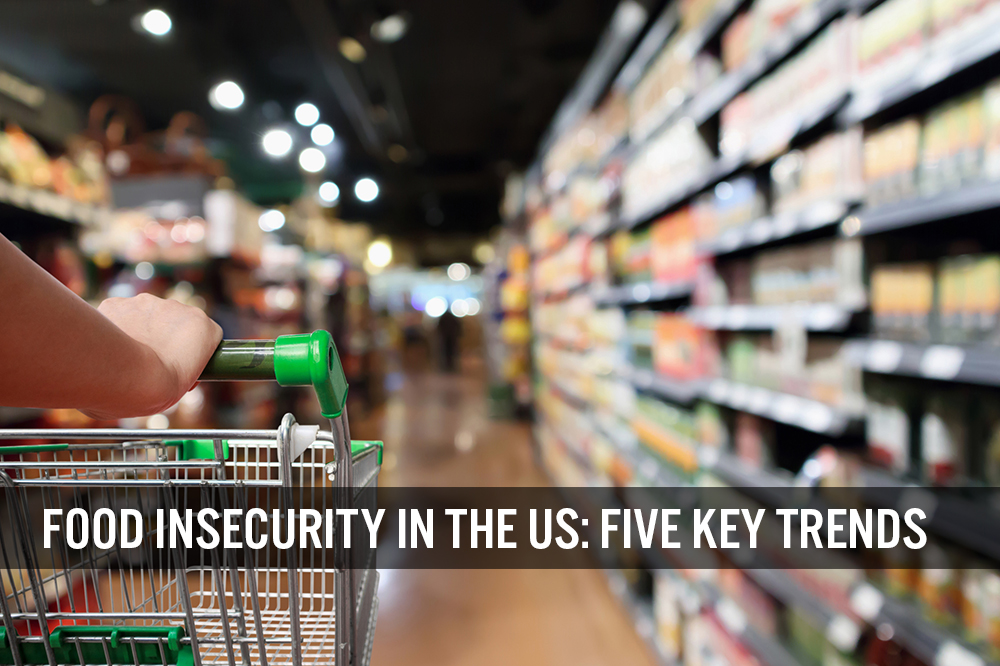
DIpil Das
What’s the Story?
Food insecurity is a lack of consistent access to enough food to lead an active, healthy life, as defined by the US Department of Agriculture (USDA). In this report, we five trends about ongoing food insecurity in the US.Why It Matters
The Covid-19 pandemic has led to a severe and widespread increase in food insecurity, affecting vulnerable households. Supermarkets form a critical component of the food system; retailers can give back to their communities and build stronger and deeper relationships with consumers by addressing food insecurity issues and launching initiatives to reduce hunger and improve access to healthier food.Food Insecurity in the US: Coresight Research Analysis
We outline five trends about US food insecurity in Figure 1 and explore each in detail below.Figure 1. Food Insecurity in the US: Five Key Trends [caption id="attachment_136263" align="aligncenter" width="725"]
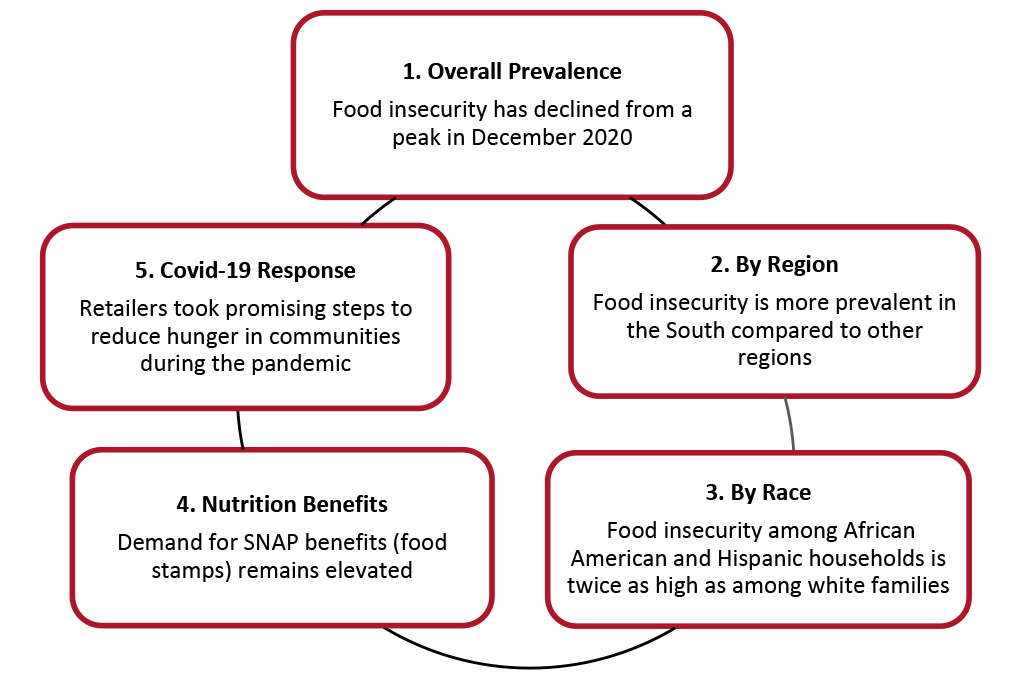 Source: Coresight Research[/caption]
1. Food Insecurity Has Declined from a Peak in December 2020
According to our analysis of Household Pulse Survey data from the US Census Bureau, fewer Americans are currently experiencing food shortages than a year ago. The proportion of US adults that reported food insufficiency (sometimes or often not enough to eat) in the prior seven-day period peaked in December 2020, at 13.7% (see Figure 2). This rate has trended downward after staying consistent at 9.7% during the June–July 2021 period, falling to 7.8% in mid-August, the lowest level since the onset of the pandemic in the US in March 2020. However, a recent uptick—likely due to the implications of a resurgence of Covid-19 cases—saw the proportion rise to 9.4% as of October 11, 2021.
Source: Coresight Research[/caption]
1. Food Insecurity Has Declined from a Peak in December 2020
According to our analysis of Household Pulse Survey data from the US Census Bureau, fewer Americans are currently experiencing food shortages than a year ago. The proportion of US adults that reported food insufficiency (sometimes or often not enough to eat) in the prior seven-day period peaked in December 2020, at 13.7% (see Figure 2). This rate has trended downward after staying consistent at 9.7% during the June–July 2021 period, falling to 7.8% in mid-August, the lowest level since the onset of the pandemic in the US in March 2020. However, a recent uptick—likely due to the implications of a resurgence of Covid-19 cases—saw the proportion rise to 9.4% as of October 11, 2021.
Figure 2. Proportion of US Adults That Reported There Was Either Sometimes or Often Not Enough To Eat in the Past Week (% of US Population) [caption id="attachment_136264" align="aligncenter" width="726"]
 Source: US Census Bureau/Coresight Research[/caption]
Before the Covid-19 outbreak, some 13.8 million households, or 10.5% of all US households, experienced food insecurity at some period during 2019, according to the USDA; although that was significantly down from 11.1% in 2018. According to the latest annual USDA data released on September 8, 2021, the prevalence of food insecurity remained unchanged from 2019 to 2020, at 10.5% (see Figure 3).
Source: US Census Bureau/Coresight Research[/caption]
Before the Covid-19 outbreak, some 13.8 million households, or 10.5% of all US households, experienced food insecurity at some period during 2019, according to the USDA; although that was significantly down from 11.1% in 2018. According to the latest annual USDA data released on September 8, 2021, the prevalence of food insecurity remained unchanged from 2019 to 2020, at 10.5% (see Figure 3).
Figure 3. Food Security in the US (% of US Households) [caption id="attachment_136265" align="aligncenter" width="725"]
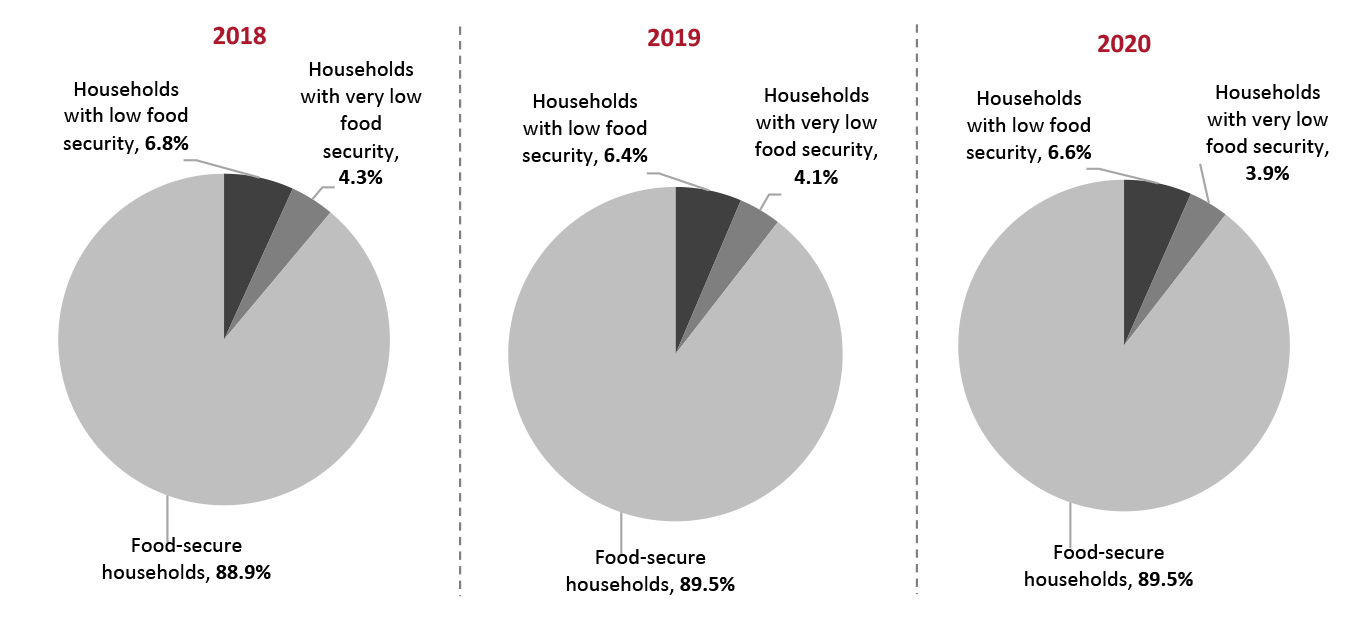 Source: USDA[/caption]
2. Food Insecurity Is More Prevalent in the South Compared to Other Regions
People are most likely to be short on food in Southern states, according to USDA data: Regionally, the food insecurity rate was higher in the South (12.3%) than in the Northeast (9.3%), West and Midwest (both 9.5%) for the combined period of 2018 to 2020. In Mississippi, 15.3% of households were food insecure—the highest rate in the US. The lowest rate, 5.7%, was in New Hampshire.
Source: USDA[/caption]
2. Food Insecurity Is More Prevalent in the South Compared to Other Regions
People are most likely to be short on food in Southern states, according to USDA data: Regionally, the food insecurity rate was higher in the South (12.3%) than in the Northeast (9.3%), West and Midwest (both 9.5%) for the combined period of 2018 to 2020. In Mississippi, 15.3% of households were food insecure—the highest rate in the US. The lowest rate, 5.7%, was in New Hampshire.
Figure 4. State-Level Food Insecurity Rate for the Combined Period 2018–2020 [caption id="attachment_136266" align="aligncenter" width="724"]
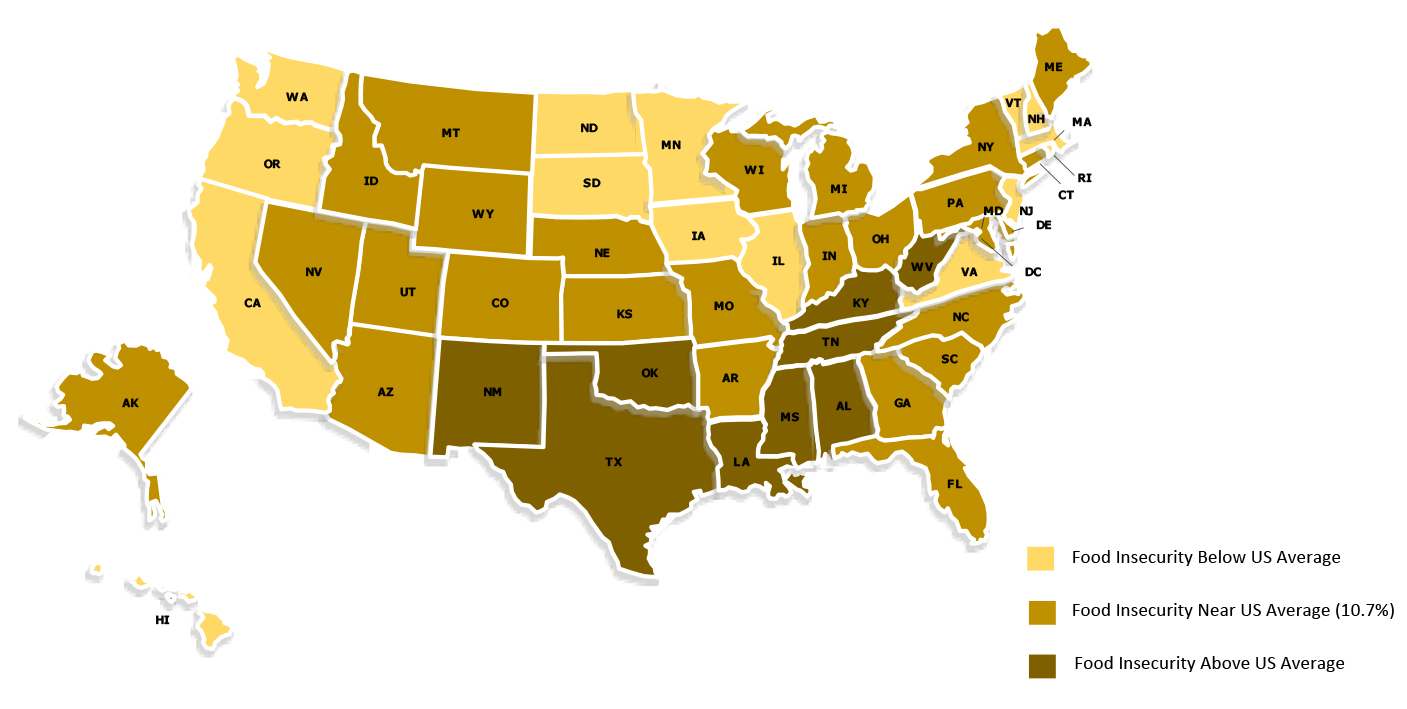 Source: USDA[/caption]
3. Food Insecurity Among African American and Hispanic Households Is Twice as High as Among White Families
African American and Hispanic families are more likely to lack consistent access to food than white families. While 21.7% of African American families and 17.2% of Hispanic families were food insecure in 2020, only 7.1% of white non-Hispanic families were, according to the USDA.
In the latest Household Pulse Survey for the week ended October 11, 2021, around 12.6% of Hispanic and 13.5% of African American households said they experienced food scarcity in the last seven days, more than twice that of white households. Longstanding gaps in wealth and wages indicate that African American and Latino households will take longer to bounce back from increased food scarcity amid the Covid-19 pandemic.
Source: USDA[/caption]
3. Food Insecurity Among African American and Hispanic Households Is Twice as High as Among White Families
African American and Hispanic families are more likely to lack consistent access to food than white families. While 21.7% of African American families and 17.2% of Hispanic families were food insecure in 2020, only 7.1% of white non-Hispanic families were, according to the USDA.
In the latest Household Pulse Survey for the week ended October 11, 2021, around 12.6% of Hispanic and 13.5% of African American households said they experienced food scarcity in the last seven days, more than twice that of white households. Longstanding gaps in wealth and wages indicate that African American and Latino households will take longer to bounce back from increased food scarcity amid the Covid-19 pandemic.
Figure 5. Proportions of US Adults That Reported There Was Either Sometimes or Often Not Enough To Eat in the Past Week, Breakdown by Race (% of US Adult Population in Each Race) [caption id="attachment_136267" align="aligncenter" width="724"]
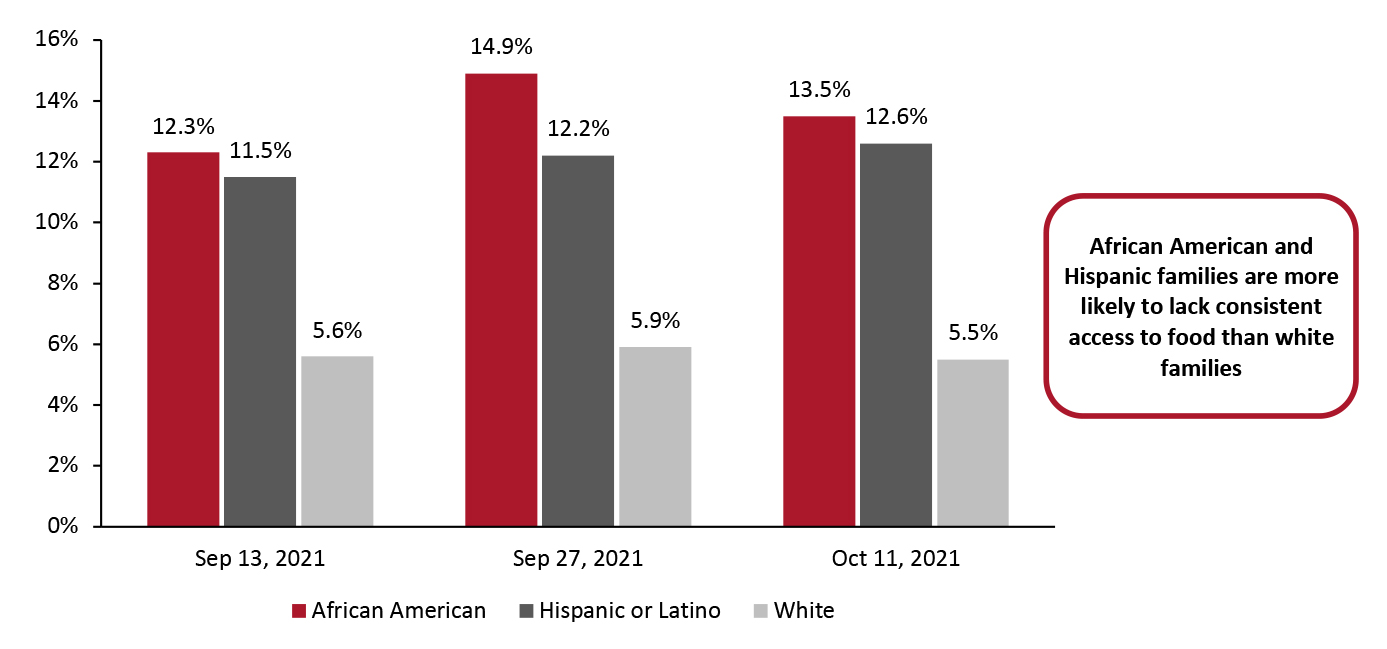 Source: US Census Bureau/Coresight Research[/caption]
4. Demand for SNAP Benefits Remains Elevated
The US government aids households experiencing food insecurity through various programs, including the National School Lunch initiative (which provides low-cost or free breakfast and lunch to school children) and multiple nutrition programs for women, infants, and children. The largest of these is the SNAP (Supplemental Nutrition Assistance Program), commonly referred to as “Food Stamps.”
According to US Census Bureau data, SNAP participation increased by 10% from around 37 million to 41 million in April 2020, the first full month of lockdown restrictions. The average monthly benefit per US household also increased from $277 to $364 due to a funding increase as part of the Families First Coronavirus Response Act that was signed into law by President Trump in March 2020.
While the number of participants on SNAP benefits has declined since its peak in June 2020, it remains elevated compared to pre-pandemic levels. In July 2021 (latest available data), approximately 43 million individuals received SNAP benefits, which accounts for 12.9% of the total US population.
Source: US Census Bureau/Coresight Research[/caption]
4. Demand for SNAP Benefits Remains Elevated
The US government aids households experiencing food insecurity through various programs, including the National School Lunch initiative (which provides low-cost or free breakfast and lunch to school children) and multiple nutrition programs for women, infants, and children. The largest of these is the SNAP (Supplemental Nutrition Assistance Program), commonly referred to as “Food Stamps.”
According to US Census Bureau data, SNAP participation increased by 10% from around 37 million to 41 million in April 2020, the first full month of lockdown restrictions. The average monthly benefit per US household also increased from $277 to $364 due to a funding increase as part of the Families First Coronavirus Response Act that was signed into law by President Trump in March 2020.
While the number of participants on SNAP benefits has declined since its peak in June 2020, it remains elevated compared to pre-pandemic levels. In July 2021 (latest available data), approximately 43 million individuals received SNAP benefits, which accounts for 12.9% of the total US population.
Figure 6. US SNAP Recipients (Mil.) [caption id="attachment_136268" align="aligncenter" width="725"]
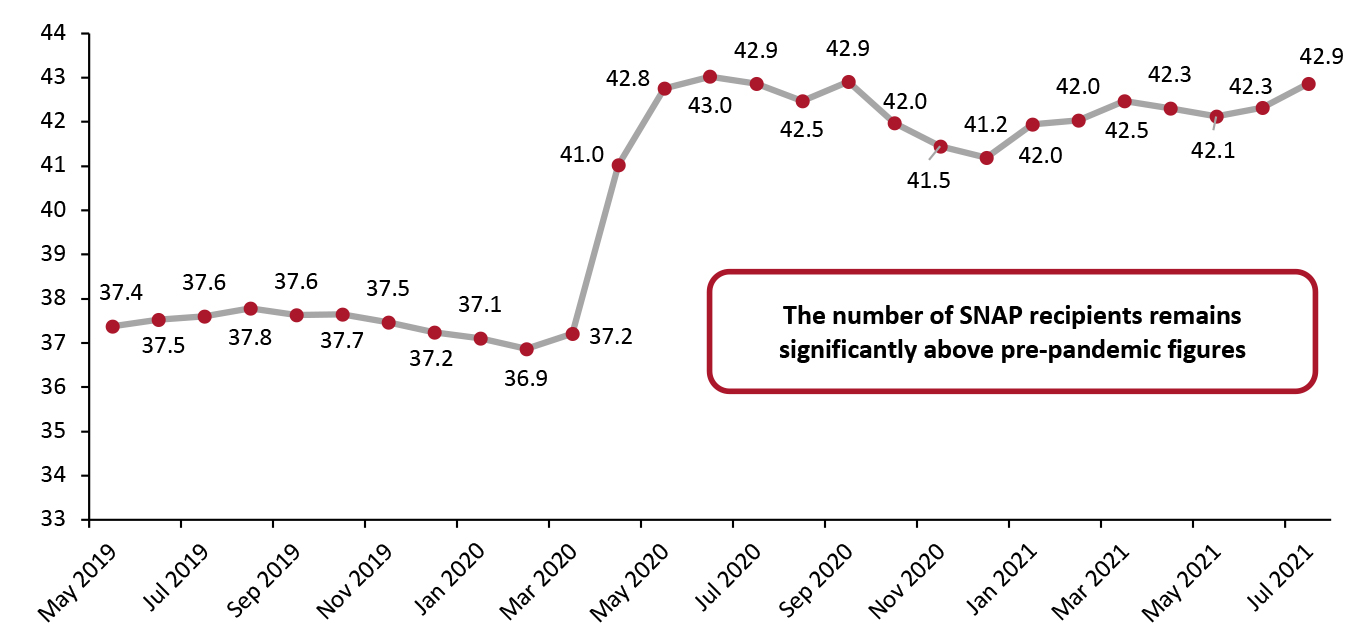 Source: US Census Bureau/Coresight Research[/caption]
The states with the highest number SNAP recipients in 2020 were California, Texas, Florida, New York and Pennsylvania. The number of individuals receiving SNAP benefits is relatively proportional to that state’s population. The states that have the highest number of SNAP participants have the largest populations in the country. Most SNAP participants in all the states live below the poverty line.
In California, 4.37 million individuals received SNAP benefits in 2020, accounting for 11.1% of the total state population; in Texas, the proportions was 12.5%; 15.7% in Florida; 13.2% in New York; and 13.6% in Pennsylvania.
Source: US Census Bureau/Coresight Research[/caption]
The states with the highest number SNAP recipients in 2020 were California, Texas, Florida, New York and Pennsylvania. The number of individuals receiving SNAP benefits is relatively proportional to that state’s population. The states that have the highest number of SNAP participants have the largest populations in the country. Most SNAP participants in all the states live below the poverty line.
In California, 4.37 million individuals received SNAP benefits in 2020, accounting for 11.1% of the total state population; in Texas, the proportions was 12.5%; 15.7% in Florida; 13.2% in New York; and 13.6% in Pennsylvania.
Figure 7. Top Five States With Largest Number of SNAP Recipients (Mil.) [caption id="attachment_136269" align="aligncenter" width="725"]
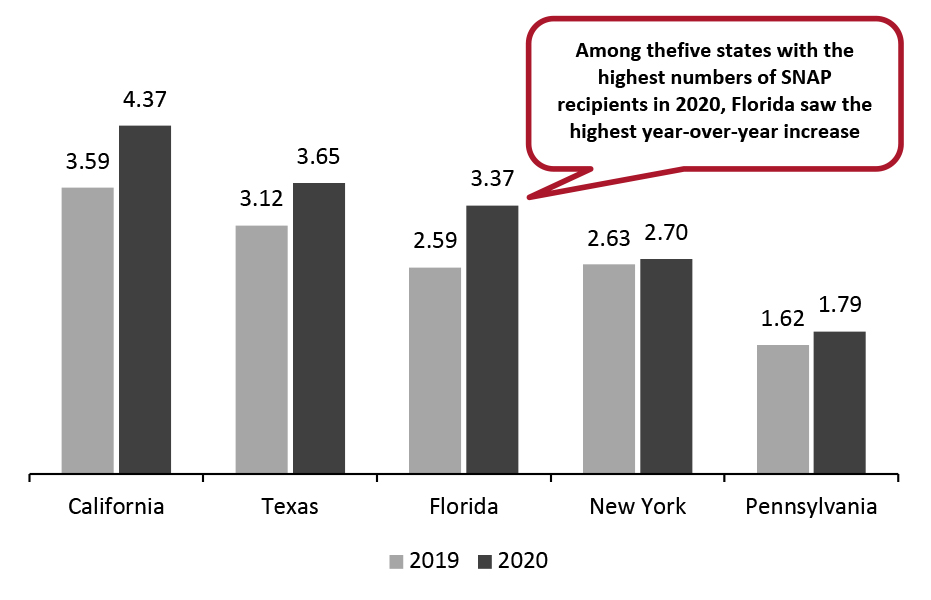 Source: USDA/Coresight Research[/caption]
The American Rescue Plan Act of 2021—a $1.9 trillion stimulus bill signed into law by President Joe Biden in March 2021—continued to expand food assistance by extending the increase in SNAP benefits and other programs. The act also greatly expanded Child Tax Credit, with eligible families receiving a payment of up to $300 per month for each child aged under six and up to $250 per month for each child aged six to 17.
Launched in April 2021, President Biden’s American Families Plan also includes investments for critical nutrition assistance to families, focusing on increasing children's access to healthy meals.
5. Retailers Took Promising Steps To Reduce Hunger in Communities During the Pandemic
Since the onset of the pandemic in the US, grocers have taken promising steps to increase their capacity to serve children, families and seniors in need with food assistance, as well as communities through delivery innovations such as online food ordering and localized pickup.
Source: USDA/Coresight Research[/caption]
The American Rescue Plan Act of 2021—a $1.9 trillion stimulus bill signed into law by President Joe Biden in March 2021—continued to expand food assistance by extending the increase in SNAP benefits and other programs. The act also greatly expanded Child Tax Credit, with eligible families receiving a payment of up to $300 per month for each child aged under six and up to $250 per month for each child aged six to 17.
Launched in April 2021, President Biden’s American Families Plan also includes investments for critical nutrition assistance to families, focusing on increasing children's access to healthy meals.
5. Retailers Took Promising Steps To Reduce Hunger in Communities During the Pandemic
Since the onset of the pandemic in the US, grocers have taken promising steps to increase their capacity to serve children, families and seniors in need with food assistance, as well as communities through delivery innovations such as online food ordering and localized pickup.
- Through its Zero Hunger Zero Waste program, Kroger directed $213 million in charitable donations to alleviate food insecurity in its stores’ communities last year. The company said its charitable giving as an organization totaled $301 million in 2020. Kroger reported that, including food and funds, it provided 640 million meals to families struggling food scarcity nationwide last year, up from 493 million meals in 2019.
- Walmart announced in December 2020 that through the Walmart Foundation, it is granting $12 million over two years to hunger-relief organization Feeding America, which has a nationwide network of 200 local food banks. The grant will support Feeding America member food banks, enabling them to increase the amount of food they can source and distribute. It will also help expand the reach of the Order Ahead click-and-collect app to more locations. Order Ahead allows individuals and households experiencing food insecurity to order ahead from a food bank and pick up their order from a designated location or have it delivered. This helps ease lines and shorten wait times at food banks during distribution hours.
- Through its Nourishing Neighbors program, Albertsons aims to fight hunger by helping keep food banks stocked, supporting meal distribution programs at schools, and supporting programs that provide food to seniors. According to the retailer, the program enabled 350 million meals in 2020, invested $10.4 million to feed school children during the pandemic and allocated $9 million for hunger programs aiding Black, Indigenous, People of Color (BIPOC) communities.
 Albertsons’ Nourishing Neighbors program achievements in 2020
Albertsons’ Nourishing Neighbors program achievements in 2020 Source: Albertsons Companies[/caption]
What We Think
The pandemic has caused a public health crisis, the effects of which are widespread. The repercussions include added hardships for populations already facing challenges as well as a rise in the number of people experiencing food insecurity. Federal nutrition programs, including the SNAP and retailers’ hunger initiatives, continue to be an important line of defense against food insecurity. Although promising steps have been taken to increase access to benefits, the pandemic is not over yet, and the future remains tenuous for families who have experienced challenges accessing enough food. It will take continued efforts from public-private partnerships across the government, the private sector and the charitable food system to ensure people experiencing food insecurity weather the crisis. Implications for Retailers- Grocery retailers with stores in low-income neighborhoods that accept SNAP payments should devote more shelf space to fresh foods and should advertise more on healthy food options.
- Retailers should incorporate mobile pantry programs to serve food insecure households—including families in significantly underserved or hard-to-reach areas—by directly distributing food, focused on fresh items such as meat and produce.